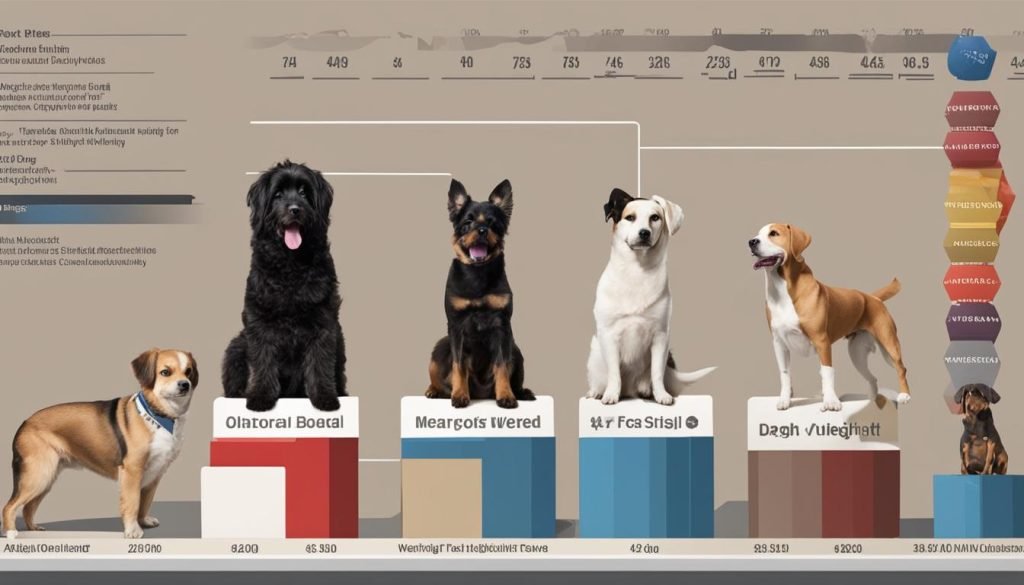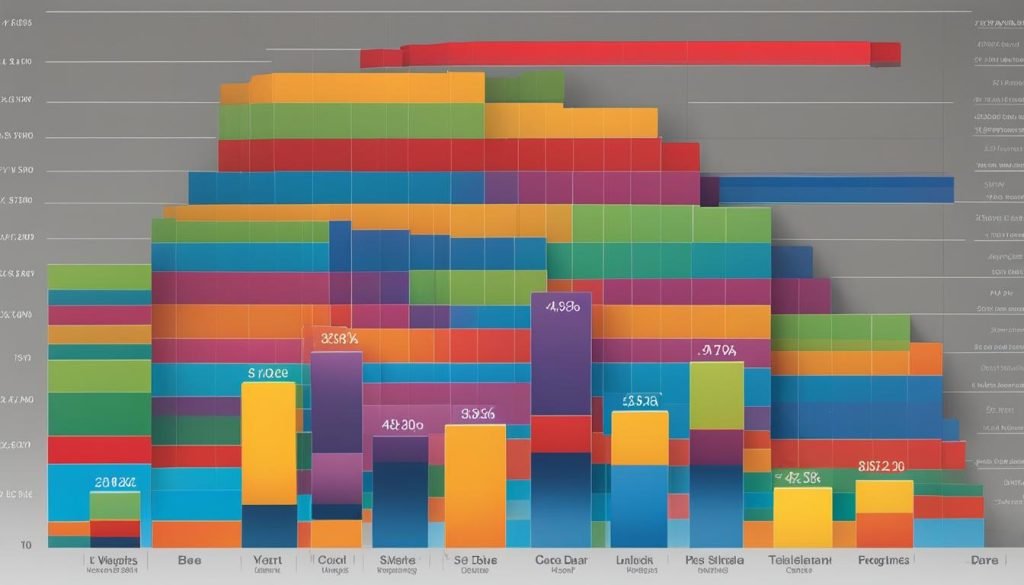How Much Do Dogs Weigh? Average Dog Weight by Breed Guide
The weight of dogs can vary greatly depending on their breed. We have written this comprehensive guide to the average weight range for different dog breeds. This information can be useful for determining if your dog is at a healthy weight and for estimating the weight of a puppy based on its breed.
Key Takeaways:
- Understanding the average weight range for different dog breeds can help assess your dog’s weight.
- Estimating a puppy’s weight based on its breed can help plan their nutrition and care.
- Small dog breeds generally have lower average weights compared to large dog breeds.
- Monitoring your dog’s weight and consulting with a veterinarian can ensure they maintain a healthy weight.
- Implementing a healthy weight management plan may be necessary for underweight or overweight dogs.
How Much Do Dogs Weigh?

Dogs come in all shapes and sizes, with weight varying significantly between breeds. To get a better understanding of how much dogs weigh, it can be helpful to consult a dog weight chart. This chart provides a range of weights for different breeds, allowing you to estimate the weight of your dog or a potential puppy.
Estimating Your Dog’s Weight
Estimating your dog’s weight can be useful for various reasons, whether you’re planning a diet or selecting a new family member. A dog weight chart provides a handy reference for determining if your dog’s weight falls within a healthy range.
- The chart lists different dog breeds and their corresponding weight ranges.
- By identifying your dog’s breed, you can find the appropriate weight range to gauge their current or potential weight.
- It’s important to note that individual dogs within a breed may vary in size due to genetic factors and other influences.
Understanding Dog Weight Ranges
When consulting a dog weight chart, it’s essential to remember that weight ranges can vary depending on the breed. Some breeds are naturally larger and heavier, while others are smaller and more lightweight. Here’s an example of a dog weight chart for different breeds:
| Breed | Weight Range |
|---|---|
| Labrador Retriever | 55-80 pounds |
| Poodle (Standard) | 45-70 pounds |
| Chihuahua | 2-6 pounds |
| German Shepherd | 50-90 pounds |
Please note that this is just an example, and actual weight ranges may differ for each breed. Refer to a reliable dog weight chart for accurate breed-specific information.
Estimating Puppy Weight
If you’re considering getting a puppy, a dog weight chart can also help estimate their future weight. By knowing the breed of the puppy’s parents, you can determine the potential weight range for your new furry companion.
“Consulting a dog weight chart can provide valuable insights when estimating your puppy’s adult weight. Remember that individual development and genetics can affect the ultimate weight outcome.”
Knowing a dog’s weight range is particularly important for breeders and prospective owners who have certain expectations about the size and weight of a specific breed. It can also help ensure that puppies are being bred responsibly, maintaining breed standards.
Factors Affecting Dog Weight

Various factors can impact the weight of a dog, including genetics, age, sex, and body condition score. Understanding these factors is essential for managing your dog’s weight and ensuring their overall health and well-being.
Genetics
Genetics plays a significant role in determining a dog’s natural body shape and size. Different breeds have distinct genetic predispositions that influence their weight range. For example, smaller breeds tend to have a lower average weight compared to larger breeds. It’s important to consider your dog’s breed when assessing their weight and setting weight management goals.
Age
Age is another factor that affects a dog’s weight. Puppies, especially during their rapid growth phase, tend to gain weight quickly. As they mature into adulthood, their weight stabilizes. Monitoring your dog’s weight throughout their life stages is crucial to ensure they maintain a healthy weight appropriate for their age.
Sex
Sex can also impact a dog’s weight. Males and females of the same breed might have slight variations in size and weight ranges. However, it’s important to note that individual variations within a breed can be more significant than the differences between sexes. Evaluating your dog’s weight based on their breed standards and individual body condition is more important than focusing solely on their sex.
Body Condition Score
The body condition score (BCS) is a tool that veterinary professionals use to assess a dog’s weight and body composition. It takes into account factors such as body fat, muscle mass, ribs, and overall appearance to determine if a dog is underweight, overweight, or at an ideal weight. The BCS provides a more accurate assessment of a dog’s overall body condition than weight alone. Regularly assessing your dog’s BCS can help you track their weight and make any necessary adjustments to their diet and exercise routine.
Understanding the factors that influence dog weight can empower you to make informed decisions about your dog’s health. By considering genetics, age, sex, and body condition score, you can better manage your dog’s weight and ensure they maintain a healthy body condition.
Calculating Your Dog’s Ideal Weight

When it comes to ensuring your dog’s health and well-being, calculating their ideal weight is an important step. One method that can help determine your dog’s ideal weight is the body condition score (BCS) method. This system evaluates the amount of fat on your dog’s body by assessing key areas, such as the ribs, abdomen, and waistline.
By carefully examining these areas, you can determine if your dog is underweight, overweight, or within a healthy weight range. The body condition score provides a valuable assessment of your dog’s overall body composition and helps guide you towards their target weight.
Once you’ve assessed your dog’s body condition score, you can use a simple formula to calculate their target weight based on their current weight. This formula takes into account factors such as breed, age, and sex to provide a more accurate estimate.
Target Weight = Current Weight / (1 – Desired Body Condition Percentage)
The desired body condition percentage is typically between 10% and 25%, depending on your dog’s breed and individual needs. A lower percentage indicates a leaner body condition, while a higher percentage indicates a stockier or chunkier body condition.
For example, let’s say your dog weighs 50 pounds and you want them to have a body condition percentage of 15%. The calculation would be as follows:
Target Weight = 50 pounds / (1 – 0.15) = 58.82 pounds
Therefore, your dog’s target weight would be approximately 58.82 pounds to achieve the desired body condition.
Keep in mind that these calculations are just estimates and should be used as a guide. It’s always important to work closely with your veterinarian to determine the appropriate weight goals for your dog, as individual factors and health conditions can influence their ideal weight.
By using the body condition score method and calculating your dog’s target weight, you can help ensure they maintain a healthy weight and body composition, promoting their overall well-being.
Body Condition Score and Target Weight Examples
| Body Condition Score | Desired Body Condition Percentage | Current Weight (pounds) | Target Weight (pounds) |
|---|---|---|---|
| Underweight | 10% | 30 | 33.33 |
| Ideal Weight | 15% | 50 | 58.82 |
| Overweight | 20% | 70 | 87.50 |
Importance of Knowing Your Dog’s Weight

Knowing your dog’s weight is essential for their overall health and well-being. Whether your dog is overweight or underweight, understanding their weight can help you make informed decisions about their diet, exercise regimen, and overall care.
Importance of Weight Management
It’s crucial to maintain a healthy weight for your dog to prevent potential health problems associated with being under or overweight. Obesity in dogs can lead to a range of health issues, including joint problems, heart disease, and decreased life expectancy. On the other hand, underweight pets may have a weakened immune system and be more susceptible to infections and other health complications.
Implementing a weight loss program is essential if your dog is overweight. This program should involve a combination of calorie restriction, balanced nutrition, and regular exercise. A supervised weight loss plan can help your dog shed excess weight safely and gradually, improving their quality of life and reducing the risk of obesity-related health problems.
Addressing Underweight Pets
If your dog is underweight, knowing their target weight can help you address any underlying health issues and develop a plan to help them healthily regain weight. Consulting with a veterinarian can provide valuable insights into potential causes of weight loss and guide you in developing a suitable feeding and care routine.
Regular Monitoring of Weight
Regularly monitoring your dog’s weight is crucial for tracking their progress and ensuring they maintain a healthy body condition. By monitoring their weight, you can quickly identify any sudden changes that may require veterinary attention. It is recommended to monitor your dog’s weight at home or during routine veterinary visits. This allows you to make necessary adjustments in their diet and exercise routine to maintain their weight within a healthy range.
Using the Dog Weight Chart for Different Breeds
One of the valuable tools available to dog owners is the dog weight chart. This chart provides breed-specific weight ranges that can serve as a useful guideline for determining if your dog is within a healthy weight range. It takes into account the variance in weight within a breed, considering factors such as genetics and individual metabolism.
By referencing the dog weight chart, you can get a general idea of the expected weight range for your specific breed of dog. This information can help you assess your dog’s current weight and determine if they are underweight, overweight, or within a healthy range. This knowledge is especially relevant for puppies, as it allows you to estimate their potential weight as they grow.
Here is an example of a dog weight chart for some popular breeds:
| Breed | Weight Range |
|---|---|
| Labrador Retriever | 55-80 pounds (25-36 kg) |
| Golden Retriever | 55-75 pounds (25-34 kg) |
| German Shepherd | 75-95 pounds (34-43 kg) |
| Poodle | Toy: 6-9 pounds (3-4 kg) Miniature: 10-15 pounds (5-7 kg) Standard: 45-70 pounds (20-32 kg) |
Keep in mind that these weight ranges are approximate and can vary slightly. It’s important to consider other factors such as body condition score and overall health when assessing your dog’s weight. If you have concerns about your dog’s weight, it’s best to consult with your veterinarian for further guidance.
Implementing a Healthy Weight Management Plan
If your dog is either under or overweight, it is essential to implement a healthy weight management plan. This plan may involve calorie restriction through a tailored diet and regular exercise to help your dog reach and maintain their target weight. It’s important to consult with your veterinarian for guidance on the appropriate amount of food to feed your dog and the best exercise regimen for their specific needs.
Calorie restriction plays a crucial role in achieving a healthy weight for your dog. Your veterinarian can help you determine the appropriate caloric intake for your dog based on their age, breed, and activity level. This will ensure that your dog receives the necessary nutrients while still promoting weight loss or maintenance.
Regular exercise is another key component of a healthy weight management plan. Engaging in physical activity helps burn calories and build muscle, which can contribute to weight loss and overall fitness. Consult with your veterinarian to develop an exercise routine that suits your dog’s age, breed, and health condition.
Regular veterinary guidance is essential when implementing a weight management plan for your dog. Your veterinarian can assess your dog’s overall health, monitor their weight loss progress, and provide any necessary adjustments to the plan. They can also help address any underlying health conditions that may be contributing to weight gain or hindering weight loss.
By following a healthy weight management plan that includes calorie restriction, regular exercise, and veterinary guidance, you can help your dog achieve and maintain a healthy weight. This will not only improve their quality of life but also reduce the risk of obesity-related health issues.
Monitoring Your Dog’s Weight
Regular monitoring of your dog’s weight is crucial for tracking their progress towards their target weight. By keeping a close eye on their weight, you can ensure that they maintain a healthy body condition and avoid any potential health issues associated with being overweight or underweight. Here are some important aspects to consider when monitoring your dog’s weight:
1. Regular Weigh-ins
To effectively monitor your dog’s weight, it’s recommended to schedule regular weigh-ins. This can be done either at the veterinarian’s office or in the comfort of your own home using a specialized dog scale. Monthly weigh-ins are generally sufficient to track any changes in weight over time.
2. Body Condition Score Measurements
In addition to weighing your dog, it’s also essential to assess their body condition score (BCS) regularly. The BCS provides a more comprehensive evaluation of your dog’s overall body composition, taking into account factors such as muscle tone and fat distribution. This assessment involves visually inspecting and palpating your dog to determine if they fall within the ideal weight range for their breed.
When evaluating your dog’s body condition, pay attention to the following areas:
- Ribs: You should be able to feel the ribs easily with a slight layer of fat covering them. They should not be overly prominent or difficult to locate.
- Abdomen: The abdomen should have a slight tuck-up, indicating a healthy weight. It should not bulge or sag excessively.
- Waistline: Dogs with an ideal body condition will have a visible waistline when viewed from above. The waist should be narrower than the ribcage and hips.
By regularly assessing your dog’s body condition score, you can make any necessary adjustments to their diet or exercise routine to help them reach and maintain a healthy weight.
3. Tracking and Documentation
To ensure accurate monitoring of your dog’s weight, it’s helpful to keep a record of their measurements and body condition score. This allows you to track their progress over time and identify any trends or changes that may require further attention. You can use a simple notebook or a digital spreadsheet to document their weight, BCS, and any relevant notes or observations.
Remember that every dog is unique, and their ideal weight may vary depending on factors such as age, breed, and overall health. Consulting with your veterinarian can provide valuable guidance and help you determine the optimal weight range for your dog.
Regularly monitoring your dog’s weight and body condition score is an essential part of their overall health and well-being. By staying proactive and attentive to their weight management needs, you can ensure that they lead a happy and healthy life.
Summary and Conclusion
Understanding the weight of dogs is essential for dog owners, as it helps determine if their pets are at a healthy weight and provides insights into estimating the weight of puppies from specific breeds. To achieve and maintain a healthy weight for their dogs, owners can utilize a dog weight chart, assess the body condition score, and implement a healthy weight management plan.
By referencing a dog weight chart, owners can gain a better understanding of the expected weight range for their specific breed. This information serves as a valuable guideline to identify if a dog is within a healthy weight range. Additionally, assessing the body condition score allows owners to evaluate the amount of fat on their dog’s body, determining if their pet is underweight, overweight, or within a healthy range.
To help their dogs reach and maintain a healthy weight, owners should implement a customized weight management plan. This plan may include a balanced diet with calorie restriction and regular exercise. Owners need to consult with a veterinarian to receive guidance on the appropriate amount of food to feed their dogs and the best exercise regimen for their specific needs.
Regular monitoring of a dog’s weight is vital to track progress towards the target weight. This can be done through monthly weigh-ins at the veterinarian’s office or by using a home scale that is suitable for weighing dogs. Continuous assessment of the body condition score ensures that dogs maintain a healthy weight and body composition. With vigilant monitoring and veterinary guidance, dog owners can ensure the overall health and well-being of their beloved pets.







